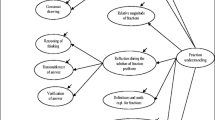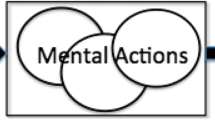Abstract
The concept of equivalence class plays a significant role in the structure of Rational Numbers. Piaget taught that in order to help elementary school children develop mathematical concepts, concrete objects and concrete reflection-enhancing-activities are needed. The “Shemesh” software was specially designed for learning equivalence-classes of fractions. The software offers concrete representations of such classes, as well as activities which cannot be constructed without a computer. In a discrete Cartesian system students construct points on the grid and learn to identify each such point as a fraction-numeral (a denominator-numerator pair). The children then learn to construct sets of such points, all of which are located on a line through the origin point. They learn to identify the line with the set of its constituent equivalent fractions. Subsequently, they investigate other phenomena and constructions in such systems, developing these constructions into additional fraction concepts. These concrete constructions can be used in solving traditional fraction problems as well as in broadening the scope of fraction meaning. Fifth-graders who used “Shemesh” in their learning activities were clinically interviewed several months after the learning sessions ended. These interviews revealed evidence indicating initial actual development of the desired mathematical concepts.
Similar content being viewed by others
REFERENCES
Arnon, I. (1998). In The Mind's Eye: How Children Develop Mathematical Concepts-Extending Piaget's Theory. Unpublished doctoral dissertation, School of Education, Haifa University.
Arnon, I., Nesher, P. and Nirenburg, R. (1999). What can be learnt about fractions only with computers. In O. Zaslavsky (Ed.), Proceedings of the Twenty-Third International Conference for the Psychology of Mathematics Education II (pp. 33-40). Haifa, Israel.
Asiala, M., Brown, A., DeVreis, D., Dubinsky, E., Mathews, D. and Thomas, K. (1996). A framework for research and curriculum development in undergraduate mathematical education. Research in Collegiate Mathematical Education II, CBMS 6, 1-32.
Behr, M.J., Lesh, R., Post, T.R. and Silver, E.A. (1983). Rational number concepts. In R. Lesh and M. Landau (Eds), Aquisition of Mathematics Concepts and Processes (pp. 91-126). New York: Academic Press.
Behr, J., Harel, G., Post, T. and Lesh, R. (1992). Rational number, ratio and proportion. In Douglas A. Grouws (Ed.), Handbook of Research on Mathematics Teaching and Learning (pp. 296-333). New York: Macmillen Publishing Company.
Czarnocha, B., Dubinsky, E., Prablu, V. and Vidakovic, D. (1999). One theoretical perspective in undergraduate mathematics education research. Proceedings of the 23rd Conference of the International Group for the Psychology of Mathematics Education 1 (pp. 95-110).
Confrey J. and Scerano, G.H. (1995). Splitting reexamined: Results form a three-year Longitudinal study of children in grades three to five. Paper Presented at the 17th Annual Meeting of the North American Chapter of the International Group for the Psychology of Mathematics Education, PMA-NA. Columbus, OH.
Dubinsky, E. (1989). A learning theory approach to calculus. Proceedings of the St. Olaf Conference on Computer Algebra Systems. Northfield, Minesota.
Dubinsky, E. (1991). Reflective abstraction in advanced mathematical thinking. In D. Tall (Ed.), Advanced Mathematical Thinking (pp. 95-123). Dordrecht/Boston/London: Clair Academic Publishers.
Fischbein, E., Jehiam, R. and Cohen, D. (1995). The concept of irrational numbers in high-school students and prospective teachers. Educational Studies in Mathematics 29: 29-44.
Freudenthal, H. (1973). Mathematics as an Educational Task. Dordrecht, The Netherland: Reidel.
Inhelder, B., Sinclair, H. and Bovet, M. (1974). Learning and the Development of Cognition (S. Wedgwood, trans.). London: Routland & Kegan Paul Ltd. (Original work published 1974).
Kalman, D. (1985). Up fractions! Up n divided by m! Arithmetic Teacher 32(8): 42-43.
Kaput, J.T. (1985). Multiplicative Word Problems and Intensive Quantities: An Integrative Software Response. ETC Technical report, Word problem Project. Unpublished manuscript.
Karplus, R., Pulos, S. and Stage, E. (1983). Proportional reasoning of early adolescents.In R. Lesh and M. Landau (Eds), Aquisition of Mathematics Concepts and Processes (pp. 45-90). New York: Academic Press.
Kieren, T.A. (1976). On the mathematical, cognitive and instructional foundations of rational numbers. In R.A. Lesh (Ed.), Number and Measurement: Papers from a Research Workshop, Eric/Smeac (pp. 101-144). Columbus.
Kieren, T.A. (1980). Knowing rational numbers: Ideas and symbols. In M.M. Lindquist (Ed.), Selected Issues in Mathematics Education (pp. 68-81). Chicago: National Society for the Study of Education, and Reston, VA: National Council of Teachers of Mathematics.
Lamon, S.J. (1993). Ratio and proportion: Connecting content and children's thinking. Journal for Research in Mathematics Education 24(1): 41-61.
Lemerise, T. and Côté, B. (1991). La Fisée fraction: Une exploration inusitée des notions d'équivalence et d'ordre. In F. Furinghetti (Ed.), Proceedings of the Fifteenth International Conference for the Psychology of Mathematics Education II, (pp. 285-292). Assisi, Italy.
Linchevsky, L. and Vinner, S. (1989). Canonical representations of fractions as cognitive obstacles in elementary teachers. In G. Vergnaud, J. Rogalsky and M. Artigue (Eds), Actes de la 13eme Conférence Internationale [Proceedings of the Thirteenth International Conference for the] Psychology ofMathematics Education, 2 (pp. 242-249). Paris, France.
Nesher, P. (1988). Beyond constructivism (Learning mathematics at school). In A. Borbas (Ed.), Proceedings of the Twelfth Annual Conference of the International Group for the Psychology of Mathematics Education I (pp. 54-74). Veszprem, Hungary.
Nesher, P. (1989). Microworlds in mathematical education: A pedagogical realism. In L.B. Resnick (Ed.), Knowing, Learning & Instruction (pp. 187-215). Hillsdale, N.J: Lawrence Erlbaum Associates.
Piaget, J. (1970). Structuralism (C. Mascher, Trans.). New York: Basic Books, Inc., Publishers. (Original work published 1968).
Piaget, J. (1975). Piaget's theory (G. Cellerier and J. Langer, trans.). In P.B. Neubauer (Ed.), The Process of Child Development (pp. 164-212). New York: Jason Aronson.
Piaget, J. (1976). The Grasp of Consciousness (S. Wedgwood, Trans.). Cambridge, Massachusetts: Harvard University Press. (Original work published 1974).
Resnick, L.B. and Omanson, S. S. (1987). Learning to understand arithmetic. In R. Glaser (Ed.), Advances in Instructional Psychology, V. 3 (pp. 41-95). Hillsdale, N.J: Lawrence Erlbaum Associates.
Smith, J.P. III, (1995). Competent reasoning with rational numbers. Cognition and Instruction 13(1): 3-50. Lawrence Erlbaum Associates, Inc.
Spindler, K. (1994), Abstract Algebra with Applications. New York, Basel, Hong Kong: Marcel Dekker, Inc.
Vergnaud G. (1988). Multiplicative structures. In J. Hiebert and M.J. Behr (Eds), Number Concepts and Operations in the Middle Grades (pp. 141-161). Hillsdale. N.J.: Erlbaum, and Reston, Va.: National Council of Teachers of Mathematics.
Yerushalmy, M. (1991). Student perceptions of aspects of algebraic functions using multiple representation software. Journal of Computer-Assisted Learning 7: 42-57.
Zazkis R. and Campbell, C. (1996) Divisibility and multiplicative structure of natural numbers: Preservice teachers' understanding. Journal for Research in Mathematics Education 27(5): 540-563.
Author information
Authors and Affiliations
Rights and permissions
About this article
Cite this article
Arnon, I., Nesher, P. & Nirenburg, R. Where do Fractions Encounter their Equivalents? – Can this Encounter Take Place in Elementary-School?. International Journal of Computers for Mathematical Learning 6, 167–214 (2001). https://doi.org/10.1023/A:1017998922475
Issue Date:
DOI: https://doi.org/10.1023/A:1017998922475




